Essential Herbs for Your Subtropical Kitchen Garden
Introduction
Establishing a kitchen garden in subtropical climates offers a unique opportunity to cultivate a diverse array of herbs that thrive in warmth and humidity. These herbs not only enhance culinary creations but also contribute to health and well-being. Their adaptability makes them invaluable additions to any garden in such regions.
Basil (Ocimum basilicum)
Basil, often hailed as the "king of herbs," is integral to various cuisines, notably Italian and Southeast Asian. In subtropical regions, varieties like sweet basil and Thai basil flourish. Plant basil in well-drained soil with ample sunlight. Regular pruning encourages bushier growth and prevents early flowering, ensuring a continuous supply of aromatic leaves. Mint (Mentha spp.)
Mint's refreshing flavor enhances beverages, desserts, and savory dishes. Its robust growth can become invasive; thus, container planting is advisable. Place mint in partial shade with consistently moist soil. Regular harvesting promotes healthy growth and prevents legginess.
Rosemary (Salvia rosmarinus)
Rosemary's pine-like aroma complements meats, breads, and roasted vegetables. This drought-tolerant herb prefers full sun and well-drained soil. In subtropical climates, rosemary can grow as a perennial shrub, providing year-round harvests. Prune regularly to maintain shape and encourage new growth.
Lemongrass (Cymbopogon citratus)
Lemongrass imparts a citrusy zest to teas, soups, and curries. Thriving in warm, humid conditions, it requires full sun and well-drained soil. Space plants adequately to accommodate their clumping growth habit. Harvest stalks by cutting at the base, ensuring the plant's continual growth.
Thai Basil (Ocimum basilicum var. thyrsiflora)
Distinct from sweet basil, Thai basil offers an anise-like flavor essential in Southeast Asian dishes. It thrives in warm climates with full sun exposure. Regular harvesting of leaves and flowers encourages prolonged production. Ensure soil remains moist but not waterlogged to prevent root rot.
Cuban Oregano (Coleus amboinicus)
Also known as Mexican mint, Cuban oregano boasts thick, aromatic leaves used in Caribbean and Asian cuisines. It prefers partial shade and well-drained soil. Given its succulent nature, overwatering should be avoided. Regular pruning prevents legginess and promotes bushier growth.
Turmeric (Curcuma longa)
Renowned for its vibrant color and medicinal properties, turmeric is a staple in many cuisines. It thrives in warm, humid climates with partial shade. Plant rhizomes in well-drained soil, ensuring they remain moist. Harvest occurs when leaves yellow and die back, revealing mature rhizomes.
Ginger (Zingiber officinale)
Ginger's spicy warmth enhances both sweet and savory dishes. It flourishes in subtropical regions, requiring partial shade and rich, moist soil. Plant rhizomes with visible buds, maintaining consistent moisture. Harvest by carefully lifting sections of the plant, allowing the remainder to continue growing.
Conclusion
Integrating these essential herbs into your subtropical kitchen garden not only elevates your culinary endeavors but also enriches your gardening experience. Their adaptability to warm, humid climates ensures vigorous growth and bountiful harvests. By cultivating a diverse selection of herbs, you create a garden that is both functional and aromatic, providing fresh ingredients and a sensory retreat just steps away from your kitchen.




